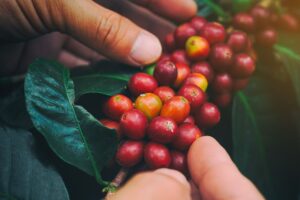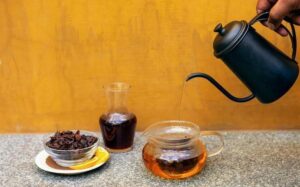Coffee and cherry pie go together like, well, pie and coffee. Coffee beans initially come from a small fruit we know as a coffee cherry. If coffee is so good to drink, can you make cherry pie from a coffee cherry to go with it?
What is a coffee cherry?
A coffee cherry is a type of fruit called a drupe or a stone fruit. It isn’t really a cherry, like the kind you make a cherry pie from, but it does kind of look like one. They are about the size of a grape and grow in small clusters along the branches of coffee plants. Unripe coffee cherries have a yellowish to bright green color and turn more orange to red in color when they are ripe. The cherry has a tough outer skin, a layer of pulp, and a seed inside, which is what we know as the coffee bean. The riper the fruit, the more sugars have developed, and the better the coffee will taste once it is roasted and brewed.
 Can you eat a coffee cherry?
Can you eat a coffee cherry?
You most certainly can! Just like other stone fruit, the flesh inside is sweet and delicious when the fruit is ripe. The struggle with eating these fruit is that there just isn’t a lot to eat. The outer skin is probably too tough to be edible, and since this stone fruit is so small, the seed inside takes up a lot of room. This leaves very little flesh to be enjoyed. And coffee beans, before roasting, are extremely hard so you would not want to bite into one.
Coffee cherry skins are, however, used to make a delicious, fruity drink known as cascara, cascara tisane, or cascara tea. The name cascara is from the Spanish word that means skin, husk, or peel. Once the seeds of the fruit have been removed, the skins are dried until they resemble husks. These dried skins are then infused in water, which creates a fruity tea with a sweet, tangy flavor. Cascara can be brewed with either hot or cold water and has about the same amount of caffeine as black tea.
Another edible coffee cherry alternative is cascara syrup. The brewed tea is mixed with sugar to create a thick, heavy syrup. This syrup can be used to flavor drinks and coffee beverages, top pancakes, or anything else you can imagine. You can purchase it already made or you can make your own from purchased, dried coffee cherry skins.
 Although some people tout cascara tea as a superfood full of antioxidants, others claim it molds quickly and is full of toxins. You’ll have to decide for yourself if you feel cascara tea is safe to drink, but it is important to know the European Union banned the sale of cascara pending further information. Regardless, always purchase cascara or cascara syrup from a reputable vendor or skip the tea altogether.
Although some people tout cascara tea as a superfood full of antioxidants, others claim it molds quickly and is full of toxins. You’ll have to decide for yourself if you feel cascara tea is safe to drink, but it is important to know the European Union banned the sale of cascara pending further information. Regardless, always purchase cascara or cascara syrup from a reputable vendor or skip the tea altogether.
What does a coffee cherry taste like?
They don’t taste anything at all like a cup of coffee. And the raw, green coffee beans you find inside the cherries do not taste like coffee either, because they have not been roasted. While the outer skin is a bit thick and tough, the inside is what holds the flavor. The sticky pulp, or flesh, of the cherry has a tangy, refreshing taste similar to the combination of watermelon and hibiscus. The fruit is really tasty, but you don’t get much flesh out of a single cherry. Like a normal cherry, you wouldn’t want to bite into the coffee seed and break your teeth.
Can you make a pie from these fruits?
A coffee cherry pie is… technically feasible, and likely delicious. The greatest impediment is that each coffee cherry produces a meagre amount of usable fruit flesh for the pie. This means actually baking this pie would be quite a large undertaking. Each fruit would need to have both the outer skin and coffee bean seed removed. We’re talking a ton of time and labor. Plus, you’d need an awful lot of them.

There are plenty of reasons that coffee cherries aren’t available as a commercial food, like cherries, grapes, or even raisins. The dried skins are too hard to eat, and the work to remove the skin and seed from the fruit makes it prohibitively expensive. And of course, there is the risk of food-born illness from mold toxins that sometimes grow on them. If your curiosity for tasting a coffee cherry is insatiable, your best bet is to visit a coffee farm to taste one for yourself. A simpler way, though, would be to try a little cascara tea or cascara syrup.

